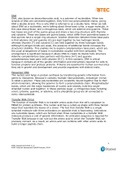DNA
DNA, also known as deoxyribonucleic acid, is a polymer of nucleotides. When two
strands of DNA are connected together, they form two polynucleotide chains, giving
DNA a double strand. This is why DNA is referred to as a double helix. When we talk
about DNA as a nucleotide, we're talking about three basic units: a sugar molecule, in
this case deoxyribose, and a nitrogenous base, which are adenine and guanine. These
two bases are part of the purine group and share a two-ring structure with thymine
and cytosine. These two bases are purine bases, which differ from pyrimidine bases in
that purines have a single ring structure. Another distinction between these base pairs
is that adenine (A) and guanine (G) are kept together by two hydrogen bonds,
whereas thymine (T) and cytosine (C) are held together by three hydrogen bonds.
Although hydrogen bonds are weak, the presence of additional bonds increases the
structure's stability. This enables me to explain complementary base pairs, which are
the usual arrangement of bases in nucleotides coupled with their antipodes. This
arrangement is significant because it allows DNA to create its double helix structure.
Adenine complementary base partners with thymine [A-T] and guanine
complementary base pairs with cytosine [G-C]. In this scenario, DNA is critical
because it contains all of the genetic information and instructions required for cells to
function properly and produce proteins. Proteins are essential for human survival since
they aid in growth and development and provide organisms with distinct traits.
Messenger RNA
This nucleic acid helps in protein synthesis by transferring genetic information from
genes to ribosomes. Because it contains multiple ribonucleotides, messenger (mrna)
is called a polymer. These polynucleotides are covalently bound together due to their
small monomers, allowing the polymer to form a polynucleotide chain. Phosphodiester
bonds, which are the major backbones of nucleic acid strands, hold this single-
stranded nucleic acid together. A ribose pentose sugar, a nitrogenous base including
uracil, cytosine, guanine, or adenine, and a phosphate group are all connected to
every ribonucleotide.
Transfer RNA (Trna)
The function of transfer RNA is to transfer amino acids from the cell's cytoplasm to
MRNA for protein synthesis. This nucleic acid has a curled-up shape with three hairpin
loops that resemble the leaves of a clover. The fact that transfer RNA is a single-
stranded molecule with three anticodons on opposite ends is fascinating. Anticodons
are nucleotide bases, which are formed when three nucleotides in a transfer RNA
molecule produce a unit of genetic information. An anticodon sequence is required for
Transfer RNA because it can rule out the amino acid to which the Transfer RNA can
precisely connect. As a result, an amino acid can combine with other amino acids to
build a longer peptide chain.
1
BTEC Assignment Brief v1.0
BTEC Internal Assessment QDAM January 2015




